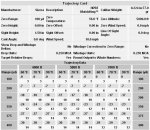It seemed time to create a range/trajectory card since our matches are moving to the 600-yard range, and I've only been able to verify my settings out to 425 yards. I created a card at JBM Ballistics (portion attached); unfortunately I did not find an explanation of what the numbers mean, either on the JBM site or in a 'net search. Let's see if I'm correct:
1. Numbers in the shaded areas indicate bullet drop in inches. I'm assuming (there's that dangerous word) that the value is the total drop at the indicated range, and that it is not a value to be applied to the preceding value. That is, based on my 100-yard zero range, the drop at 350 yards is 24 inches, and not the combination of 24 and the preceding 18 inches, for a total drop of 42 inches.
2. I *think* the numbers in the unshaded blocks indicate total number of elevation clicks for my scope that has 1/4-minute clicks. But with my zero range of 100 yards, there is no drop indicated so the meaning of the 3 eludes me. In addition, my observed 300-yard setting is a total of 20 clicks. The table shows 10, which isn't close. And with an observed setting of a total 25 clicks for 350 yards, the 12 in the block doesn't make any sense.
Can someone please clear this up for me?
Thank you for your help.
Richard
1. Numbers in the shaded areas indicate bullet drop in inches. I'm assuming (there's that dangerous word) that the value is the total drop at the indicated range, and that it is not a value to be applied to the preceding value. That is, based on my 100-yard zero range, the drop at 350 yards is 24 inches, and not the combination of 24 and the preceding 18 inches, for a total drop of 42 inches.
2. I *think* the numbers in the unshaded blocks indicate total number of elevation clicks for my scope that has 1/4-minute clicks. But with my zero range of 100 yards, there is no drop indicated so the meaning of the 3 eludes me. In addition, my observed 300-yard setting is a total of 20 clicks. The table shows 10, which isn't close. And with an observed setting of a total 25 clicks for 350 yards, the 12 in the block doesn't make any sense.
Can someone please clear this up for me?
Thank you for your help.
Richard


